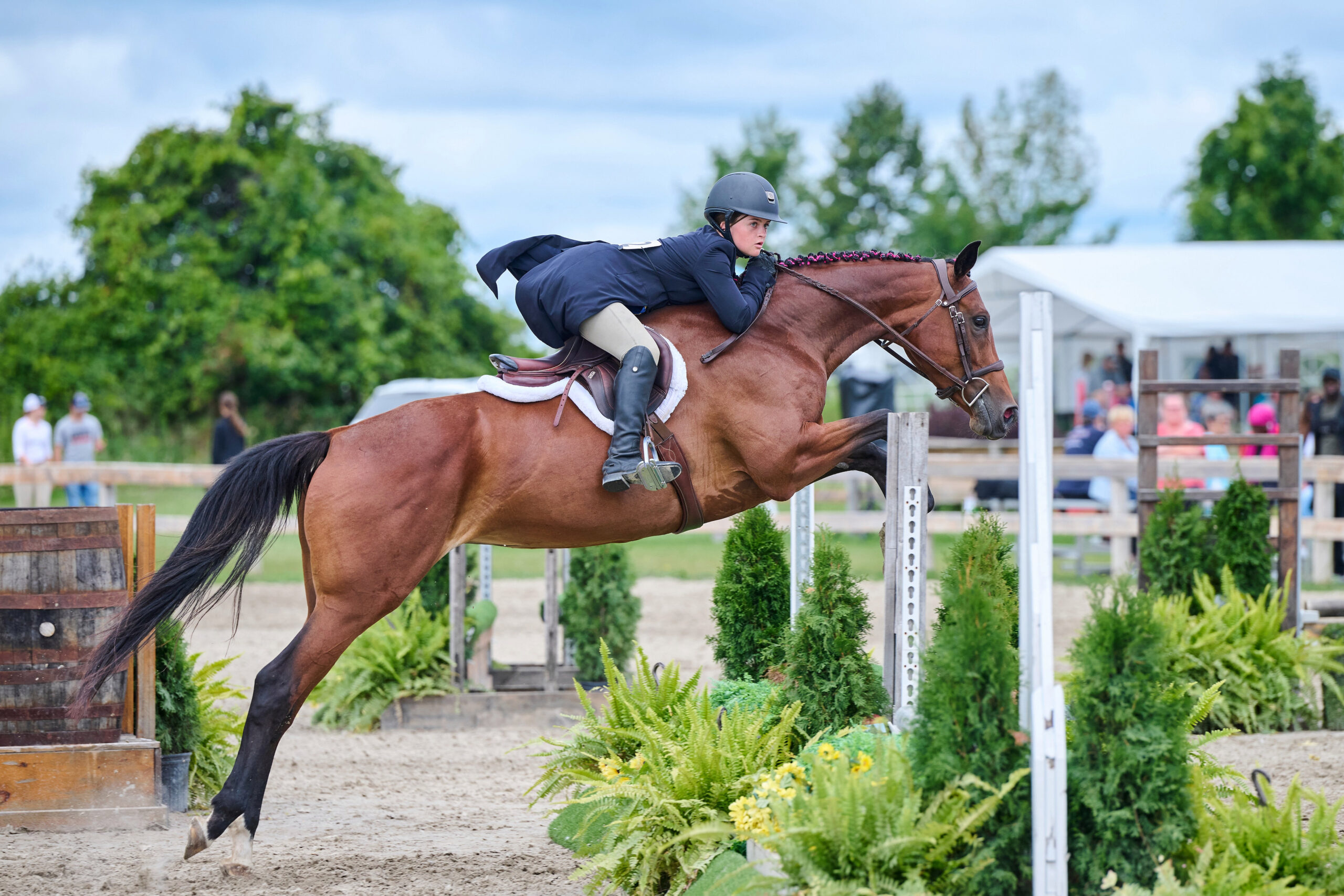hunters
All Posts & News Press Releases Success Stories Aftercare Editorials Retraining Tips Supporter Features Inspector Spotlights Previous Post Let’s Get It Did Let’s Get It Did By: Alexis Arbaugh June 7, 2024 Success Stories Tags:accredited aftercare, hunters, jumpers, LongRun Thoroughbred Retirement Society, Success story After riding and competing on ponies, Camden Conway was ready to step up to a horse. After a lot of thinking, Camden’s father concluded that adopting a horse would be the best course of action to find Camden a new horse. In 2021, Camden received her new horse as a Christmas present. Let’s Get It Did is a 2018 bay mare who ran a total of 3 times at Woodbine Racetrack. Camden’s father adopted her from LongRun Thoroughbred Retirement Society in Toronto, Ontario, Canada. Let’s Get It Did is now affectionately known as Diddy. Camden’s father was delighted that the mare “jumped over the 4-foot fence” when he arrived at LongRun. He had actually planned on adopting a different horse more suitable to what Camden needed but ultimately, he was amazed by the scope and athleticism of Diddy, so he adopted Diddy instead. Shortly after bringing home Diddy, Camden and Diddy competed in their first show where they rode in the walk/trot cross rail division. The pair did well, placing 1st in the equitation over fences, 4th in the equitation under saddle, and 6th in the hunter under saddle. Their next competition was a Silver Series show where they entered in the 0.60 and 0.70-meter jumpers. This was before Camden realized that Diddy needed more jump underneath her for her to make an effort over the jumps – the small jumps were too easy for her. For their last Silver Series Show, Camden and Diddy were entered in the 0.80-0.90 classes to encourage her “to actually pick up her feet,” wrote Camden. The pair placed in every 0.80 class and received 3rd and 8th out of a large group in the 0.90-meter. After many jumper shows, Diddy seemed to settle in nicely to the horse show life. Camden believed that she was ready to compete in a hunter derby. “She completely exceeded both my and my coach’s expectations as she got an 84 in the 2’6/2’9 derby which got her 4th in the class,” wrote Camden. Camden has her eyes set on a bright future with Diddy. She hopes to show in the 1.00 and 1.10-meter next show season. Camden wants Diddy to be the horse that she can “move up the heights with.” The 1.10 Grand Prix in the Silver Series is one of their goals. She also hopes to “get her into some jumper medals as well as the 3’/3’3 derbies for fun,” Camden wrote. Another goal for them is to compete in the Thoroughbred jumper classes and the U25 jumper classes that are on the Gold circuit. Share This Article Do you have a success story that you would like to share? Submit your experience with an accredited organization here: Success Story Submission
Read More >All Posts & News Press Releases Success Stories Aftercare Editorials Retraining Tips Supporter Features Inspector Spotlights Previous Post How to Teach Your Retired Racehorse to Jump How to Teach Your Retired Racehorse to Jump By: Alexis Arbaugh June 6, 2024 Retraining Tags:Friends of Ferdinand, hunter jumper, hunters, jumper, jumpers, Jumping, Retraining Tips, show jumping Alien Invasion – Photo provided by Lori Miller Lori Miller, Friends of Ferdinand Many people who adopt a Thoroughbred after it is retired from racing hope to train their horse for a second career, often in disciplines that involve jumping. Training a Thoroughbred to jump can be a brand-new experience for these retired athletes, as racehorses—unless experienced in steeplechase—don’t engage in jumping or even handling poles. Their primary focus is running on the flat and being trained for speed. Therefore, it can be challenging to teach an off-the-track Thoroughbred how to carefully and skillfully navigate a course of jumps. Lori Miller is the head trainer at Friends of Ferdinand, an organization accredited by Thoroughbred Aftercare Alliance. Located in Indianapolis, Indiana, Friends of Ferdinand specializes in retraining, rehabilitation, adoption, and providing sanctuary homes for Thoroughbreds retired from racing. Lori has extensive experience with racetracks and retired racehorses and takes pleasure in the retraining process, knowing that racehorses can have happy and healthy lives in new careers. Lori’s wealth of experience and knowledge makes her the perfect person to help fellow adopters navigate their new horse’s retraining process. It is difficult to determine if a horse will be a good jumper just by looking at them, as there are many factors to consider and different contexts for evaluation. “If you are at the track, it’s tough. A horse that races in blinkers or wears a shadow roll might be one that has a lot to think about,” Lori wrote. Horses that need to wear blinkers to focus generally have excess energy and are spooky. Lori generally tries to avoid spooky horses because it creates more problems when teaching them to jump. “I prefer the horses that will walk with confidence through whatever,” Lori wrote. Lori also considers conformation when assessing whether a horse would be good at jumping. She likes horses that seem to float when they travel, rather than stomp. She avoids horses with crooked legs, tiny feet, or a downhill build. Instead, she looks for horses that are balanced with an uphill build and correct angles. She prefers straight legs that allow the horse to stand under themselves and a neck that ties in high to their shoulders. Although there are outliers—horses with unconventional conformation that make wonderful jumpers—they are few and far between. A horse with a good attitude is always easier to work with than one that is grumpy or has a poor attitude. When asked about the kind of attitude or temperament she looks for, Lori replied that she seeks “the horse that wants to work with you, the horse that looks to the person rather than away”. A horse that wants to learn and seeks guidance from people is always going to excel. However, it is easier to evaluate a horse’s willingness after they have had a chance to settle down on a farm following their racing career. It usually takes some time after leaving the track for a horse to come out of its shell and show its true personality. “How they are at the track is frequently very different than they are away from home,” Lori wrote. Any horse that is friendly and easy to work with and around is a good start. “I want the horse to learn to go over what is put in front of it. Systematically by never asking it to do something we haven’t built up to. Teaching the horse to stay in a rhythm and not run, that there is no reason to get tight and anxious. I want my horses to learn it’s all positive”. Lori Miller Friends of Ferdinand So, now that you have your horse, how do you start jumping? Lori begins with basic flat work to ensure the horse is supple and responsive to the bit. She encourages the horse to move forward off the leg and be quick and accurate with transitions, ensuring the horse is always listening. After establishing a strong flat foundation, she introduces poles on the ground, having the horse casually walk, trot, and canter over them until they are no longer an issue. She wants the horse to get used to riding around standards, poles, and jumps in the arena, encouraging them to watch and continue working. When Lori feels the horse is ready to jump, she starts with a small jump that the horse can easily walk over. If the horse stops in front of the jump, she breaks it down to make it more inviting. “Slow work to build a confident horse,” Lori wrote. By this point, the horse is accustomed to going over poles and small boxes, so a small cross rail shouldn’t be a big deal. Their first actual jump might be a cross rail or a small log in the field, and the horse shouldn’t be fazed by it. Desensitizing your horse to various obstacles helps prevent stress or nervousness about jumping. When asked what Lori would like the horse to take away from their first jumping experience, she replied, “I want the horse to learn to go over what is put in front of it. Systematically by never asking it to do something we haven’t built up to. Teaching the horse to stay in a rhythm and not run, that there is no reason to get tight and anxious. I want my horses to learn it’s all positive”. Lori often trots over fences in the beginning stages of teaching a horse to jump. This allows the horse to learn to make a shape and stay straight while building confidence at a slower and more balanced pace. She advises against over-jumping young horses or those learning to jump, limiting
Read More >The Kentucky-bred daughter of To Honor and Serve never broke her maiden but she’s now finding her calling outside racing.
Read More >















